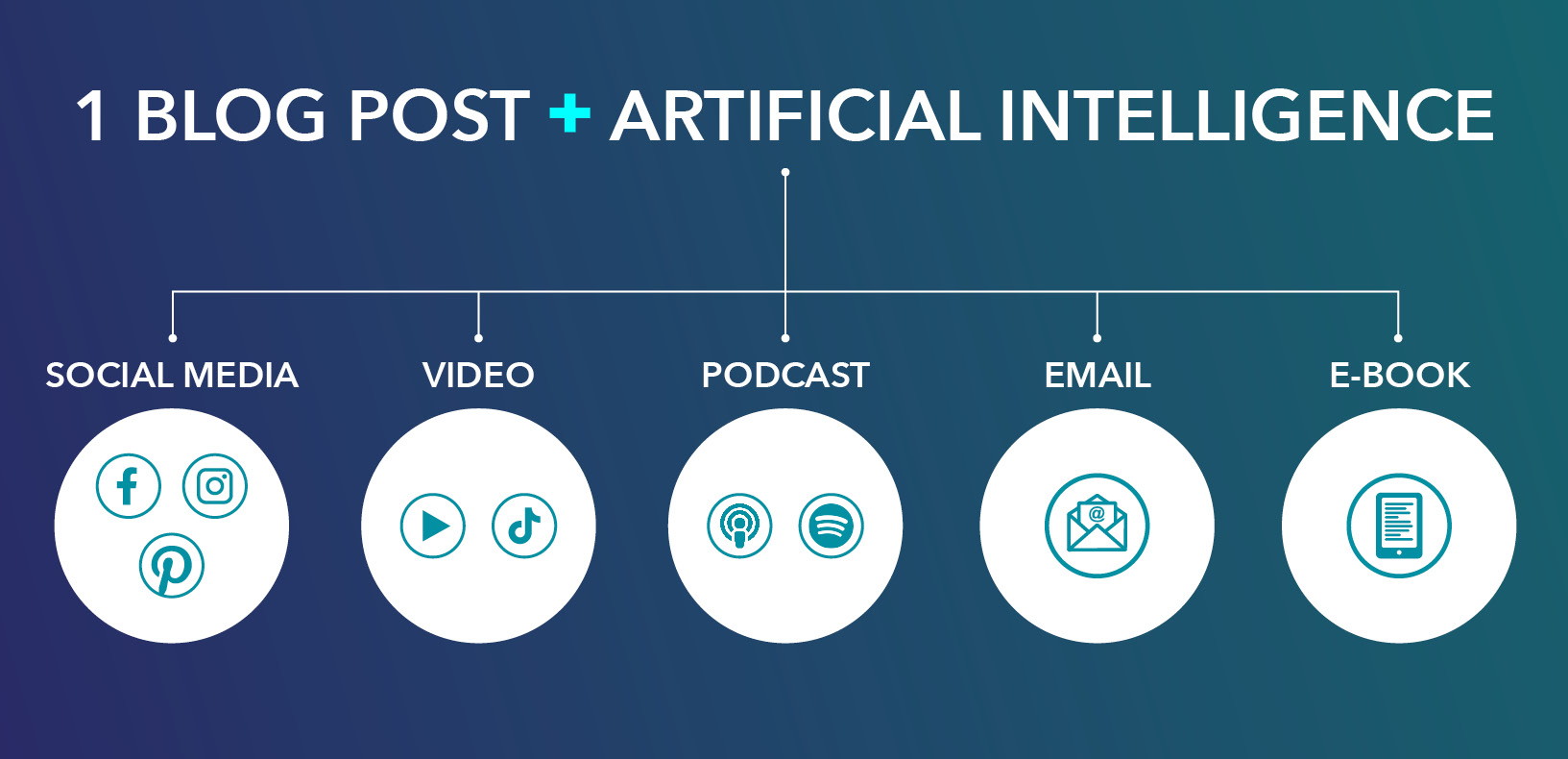The one thing real estate agents never seem to have enough of is time. With only 24 hours in each day, any tool that can increase your productivity is something worth exploring.
Generative AI, or gen AI, is a broad category of artificial intelligence that can save you precious time with its unparalleled ability to simplify your content creation. AI text generators are able to take inputted instructions and data and produce entirely new data that resembles human-created content. Give this technology the proper directions, and it will produce text, images, music, videos . . . the list goes on and on.

AI text generators are able to take inputted instructions and data and produce entirely new data that resembles human-created content.
Automated content creation is the epitome of efficiency and time-saving innovation. Real estate agents have used it to write property descriptions, email content, social media posts, blogs, video scripts, newsletters, and more—all with an eye toward economizing effort without sacrificing quality. Even so, it takes a bit of experimentation and practice to get the kind of results you’d be willing to publish.
What follows are three tips you can use to shrink your learning curve.
The first gives insight into the versatility and power of AI to create a wide variety of AI-generated content marketing from a single piece of content, enhancing your efficiency to an even greater degree. Work with this technology to produce a solid piece of content (such as a comprehensive blog article), then apply AI’s prowess to repurpose that content and effortlessly create additional material that amplifies your reach and the impact of your real estate content marketing.

Use the versatility and power of AI to create a wide variety of AI-generated content marketing from a single piece of content.
The second tip will enable you to interact with gen AI tools like ChatGPT and Gemini (formerly Bard) more productively, delivering your desired results with fewer false starts.
And in the final one, you’ll find a list of suggested prompts that will direct these tools to produce the types of content most often needed by real estate professionals.
1. Use it to repurpose content
You can benefit significantly from AI text generators by leveraging their ability to repurpose a core piece of content, such as a comprehensive blog article, into various other types of content. What follows is a brief list of the ways automated content creation can be a game changer, enhancing your ability to produce more content for more uses in less time.
Automated summarization

Generative AI can analyze the key points and themes of a piece of content and generate concise summaries in multiple formats for multiple uses.
Generative AI can analyze the key points and themes of a real estate blog article and generate concise summaries. This is particularly useful for creating shorter versions of your content, such as infographics, social media posts, or quick newsletter articles, to use in your marketing. To generate traffic, you can add a call to action such as, “To learn more, visit [your website].”
By automating the summarization process, you can save time and effort while ensuring that the core message of the original article is retained.
Social media snippets
Imagine condensing your blog’s core message into bite-size social media nuggets with the click of a button. Use ChatGPT or Gemini to craft X (formerly Twitter) posts summarizing key points, Instagram captions weaving captivating narratives, and even Facebook posts sparking community discussions.
Email-newsletter generation

Use AI to produce attention-grabbing subject lines and compelling snippets and to suggest relevant visuals for your email newsletter.
By repurposing blog articles into newsletter content via an AI text generator, you can ensure consistent messaging across different channels. Additionally, you can use it to produce attention-grabbing subject lines and compelling snippets and to suggest relevant visuals. You can even have it incorporate real-time market trends and property information, keeping your content up-to-date and relevant—contributing to the overall effectiveness of your email marketing.
(Speaking of visuals, check out Canva Pro and its “Magic Studio” suite of AI tools that will amaze you with its ability to create and edit images and videos based on descriptions you provide.)
Video-script generation

An AI-powered content creation tool can be used to convert written content into a video script, identifying crucial information and crafting text that maintains a storylike flow.
Video content has become indispensable to the real estate industry, especially when it comes to marketing your listings and producing content for social media. An AI-powered content creation tool can be employed to convert written content into a video script, identifying crucial information and crafting text that maintains a storylike flow.
From a single blog—perhaps one titled “The Five Most Common Mistakes Made by First-Time Homebuyers”—you could get one long-form video summarizing all the missteps or five shorter reels on each error with the aid of AI-generated scripts. In turn, you may dramatically enhance your presence on platforms like YouTube of Instagram. Repeat this process consistently using other blogs or content, and you’ll have a steady stream of engaging videos to post.
Interactive-content creation
Interactive content includes quizzes, polls, surveys, assessments, calculators, and games. It’s superior to static blogs insofar as it encourages engagement from your audience. Among its many benefits, it enhances the user experience, improves retention, differentiates your content amid volumes of digital noise, and produces higher conversion rates.

AI can design engaging quizzes, polls, surveys, assessments, calculators, and games from instructions you provide.
Real estate professionals can utilize this approach to make their content more appealing and shareable. For example, you could request that Gemini suggest a quiz to test users’ knowledge about the buying process. If you’re stuck for ideas, you could also ask it to use the text to tell you what types of interactive content it could create from the text provided.
Localized-content creation
“All real estate is local” is a phrase you’ve likely heard or used yourself many times. Real estate markets vary by location, and generative AI can help adapt content to particular regions. For example, you can create versions of a blog article tailored to different markets by instructing your tool of choice to analyze local trends and incorporate region-specific data. This localization enhances the relevancy of the content, making it more appealing to diverse audiences.
2. Provide detailed instructions
Among the most fascinating features of generative AI is its ability to mimic human communication, engaging in a dialogue as it would another person. Users are encouraged to chat with this technology as if it were human. However, despite continuous improvement, the fact remains that it is a soulless tool dependent on the input it’s given to produce quality content.

Generative AI is dependent on the specificity of the input it’s given to deliver high-quality content.
What follows are several tips for how real estate agents can interact with these tools to generate content that closely mimics human voice and best represents your intended purpose. In turn, you can optimize your content to consistently represent your brand, accurately reflect your message, and actively engage your audience. The key is to provide as many specific details as possible.
Assign a role
As a real estate agent, you’ll likely most often be looking to compose content that reflects your own voice, so instruct the tool to adopt the role of an agent. Flesh out the profile to reflect what makes you unique by adding details like your age, gender, location, years of experience, accreditations, and niche. Keep adding features to home in on what makes you who you are.
Provide context
Offer background information that will help inform the response. Include the purpose of the content, the audience, and what type of content is needed (e.g., blog, script). Also include an explanation of current events in the world that would influence your content.
Be clear
Instead of simply asking for a “short” article, specify “250 words about X topic for Y audience.” Use direct commands when making a request. Words like “do,” “use,” “write,” and “revise” are less confusing than “could you.” Additionally, be consistent in the words you choose. For example, when describing a property, choose between “house” or “home” and then stick with it throughout your interaction. Finally, keep your prompts short to enhance their clarity.

AI is more likely to produce the content you want when you provide it with simple and direct instructions and include as much detail as possible.
Specify tone and style
Clearly communicate the desired tone and style for your content, whether it’s casual, formal, conversational, humorous, or irreverent. Providing this guidance will help generate content that aligns with your brand.
Offer examples or comparisons
Provide examples or comparisons to showcase the style you’re looking for. You can reference specific authors or articles or even share snippets of text that capture the essence of the human voice you want in the copy.
Request storytelling elements
Our nature as storytellers means we engage well with narratives, so instruct your AI to include metaphors, examples, or tales that contribute to a more conversational and humanlike tone.
Iterate and refine

AI-generated content tends to be bland, so be sure to review and revise what you’re given so it sounds more like a real person wrote it.
Whatever response you receive, consider it the first of many drafts. AI-generated content tends to be bland because it doesn’t consider nuance, cultural context, or conventional phrases, so what it initially produces is going to sound stilted. To lessen the robotic and impersonal tone and humanize your content, one writer offers these suggestions:
- Incorporate your personal insights, experiences, or anecdotes. This can make the writing feel more authentic and relatable, enhancing the humanlike quality of the content, and promote your authority.
- Add emotional phrases, and reduce heavy-handed language. Adjectives are your friend; use them to add color and feeling to the initial drafts. Look for overly formal or ponderous words and phrases and replace them with simpler options: “use” to replace “utilize,” “help” to replace “assist,” and “try” to replace “endeavor.”
- Use an AI tool you can train to match your style. It will take some time, but there are AI models that will learn to produce your preferred voice. Offer it examples of your previous writing, style guides, business documents, and other relevant resources to help speed up the process.
3. Experiment with and save useful prompts
Prompts are any type of input you provide that are intended to produce a response. Queries or instructions, they’re at the center of the interaction between a content creator and generative AI. Well-written prompts offer context and specific details to help these tools understand your intent and provide accurate and relevant responses.

You’ll want to play with how you write prompts to see how your generative AI tool responds. When you craft that ideal prompt, save it for use again later.
For example, when crafting a property description, you want to describe it in the best light. When developing your prompts:
- Specify location and features. Clearly mention the location and specific features you want to highlight in the real estate copy. Provide details like neighborhood amenities, proximity to schools or public transportation, and any unique selling points of the property.
- Use descriptive language. Encourage the use of descriptive language to create a vivid picture of the property. Request phrases that evoke a sense of ambience and highlight the visual appeal, such as “breathtaking views,” “spacious living areas,” or “meticulously landscaped gardens.”
- Highlight key selling points. Explicitly outline the key selling points of the property, whether it’s modern kitchen appliances, luxurious bathrooms, or energy-efficient features. Ensure that the language emphasizes these aspects to attract potential buyers.
- Provide call-to-action language. Ask for a compelling call-to-action that encourages potential clients to take the next steps, such as scheduling a viewing, reaching out to you, or exploring more details on the property website.
Another good aspect to consider including is a depiction of your ideal buyer; this can make all the difference between a good and great property description.
Once your prompt has all the necessary information, submit it to your AI tool and analyze the response. It may be just what you were looking for, or it may not be fully satisfying. Note what worked and what didn’t, then save your final prompt to use again (with necessary adjustments) when you write the next one. As you repeatedly go through this process, you’ll garner a list of prompts that may well guarantee you the best response every time.
Take the next step
An important thing to keep in mind is that AI is not a replacement for your creativity; it’s simply a powerful collaborator providing automated content creation, freeing you to focus on strategy and high-level content while it handles the repetitive tasks. With its transformative abilities, a single piece of content can become a springboard for a diverse collection of real estate content marketing material, maximizing your reach, engagement, and, ultimately, your success.

AI is a powerful collaborator providing automated content creation, freeing you to focus on strategy and high-level content while it handles the repetitive tasks.
Your next step is to start playing with tools like ChatGPT, Gemini, or a similar AI tool. You’ll find differences among them, and one may better suit your needs than another. Regardless, you’ll soon be astonished by what AI can accomplish and how it can streamline your content marketing, making you wonder how you ever lived without it.



























